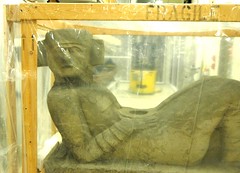
The sculpture of Henry Moore makes perfect sense, but I’m at a loss to explain why. I knew his work first as a kid through his Vertebrae on 4th Avenue in Seattle, but I didn’t know the piece was by anyone I should know anything about. I only knew that there was something solid and satisfying about it; that it transformed the sharp unreceptive lines of the plaza in which it sits into a place where I wanted to be.
When I mentioned to my brother that I was going to catch the Moore exhibit at the Denver Botanic Gardens he shared a clip that his company recently digitized for the BBC, a wonderful program called Face to Face in which Moore speaks of his influences and his process, which led me to dig through the rest of the BBC archival programming on Moore trying to find a word or phrase that could articulate what it is that he does.
I found nothing that summed it all up. But I did learn that Moore was influenced by Mexican sculpture, which I took to mean Aztec and Toltec given other references to the reclining Chaac Mool. That too made sense even though I didn’t anticipate it: like introducing two friends and discovering they already know each other, already adore one another, for all the reasons you thought they might.

Mexican sculpture seems to me to be true and right. Its ‘stoniness’, by which I mean its truth to material, its tremendous power without loss of seriousness, its astonishing variety and fertility of form invention and its approach to a full three-dimensional conception of form, make it unsurpassed in my opinion by any other period of stone sculpture.
Henry Moore cited in The Aztec World by Elizabeth Hill Boone, Smithsonian Books, Washington, 1994






No comments:
Post a Comment